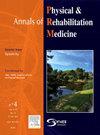The effects of exercise therapy on lumbar muscle structure in low back pain: A systematic review and meta-analysis
IF 4.6
3区 医学
Q1 REHABILITATION
Annals of Physical and Rehabilitation Medicine
Pub Date : 2025-05-01
DOI:10.1016/j.rehab.2025.101988
引用次数: 0
Abstract
Background
Changes in muscle structure are observed in people with low back pain (LBP). Although exercise therapy is arguably one of the most commonly used methods to treat LBP, evidence regarding its effects on muscle structure is still lacking.
Objectives
To answer the following questions: (1) What are the effects of exercise therapy on lumbar muscle structure in people with LBP and (2) which type of exercise intervention has the greatest effects?
Methods
Six electronic databases were systematically searched. The RoB 2 tool and the ROBINS-I tool were used to blindly assess the Risk of bias (RoB), and the RevMan 5 tool was used for the meta-analysis. Due to heterogeneity, the various exercise interventions were classified into 4 groups. Interventions that could not be classified into 1 of these 4 groups were not included in the meta-analyses and were qualitatively analysed.
Results
In total, 984 records were retrieved, of which 34 articles were included. The meta-analyses showed that when considering the overall effect size per muscle structural outcome in chronic LBP (cLBP), exercise therapy showed significant positive effects on Lumbar Multifidus (LM) muscle thickness (MT) and LM cross-sectional area (CSA), but not on Lumbar Erector Spinae (LES) CSA and Quadratus Lumborum CSA. Considering the different intervention groups, significant positive effects were observed for: (1) “Motor control + stabilization” with small effect on LM MT, (2) “Stabilization” with medium effect on LM MT, and large effect on LM CSA, and (3) “Motor control + Stabilization + Lumbar strengthening” with large effect on LM MT and LES CSA. There were no significant effects observed for “Lumbar strengthening”.
Conclusions
Overall, exercise therapy has a positive effect on lumbar muscle structural properties in a cLBP population, with a combination of Motor control + Stabilization + Lumbar strengthening giving the best results.
Database registration
This systematic review was registered on PROSPERO (CRD42021232583).
运动疗法对腰痛患者腰肌结构的影响:一项系统回顾和荟萃分析
腰痛(LBP)患者的肌肉结构发生变化。尽管运动疗法可以说是治疗下腰痛最常用的方法之一,但关于其对肌肉结构的影响的证据仍然缺乏。目的回答以下问题:(1)运动疗法对腰痛患者腰肌结构的影响;(2)哪种运动干预效果最大?方法系统检索6个电子数据库。采用rob2工具和robins - 1工具进行盲法偏倚风险(Risk of bias, RoB)评估,采用RevMan 5工具进行meta分析。由于存在异质性,我们将各种运动干预措施分为4组。不能归类为这4组中的1组的干预措施不包括在荟萃分析中,并进行定性分析。结果共检索文献984篇,纳入文献34篇。荟萃分析显示,当考虑慢性腰痛(cLBP)的每个肌肉结构结果的总体效应大小时,运动治疗对腰椎多裂肌(LM)肌肉厚度(MT)和LM横截面积(CSA)有显著的积极影响,但对腰竖肌(LES) CSA和腰方肌CSA没有显著的积极影响。考虑到不同的干预组,观察到显著的正效应:(1)“运动控制+稳定”对LM MT效果小,(2)“稳定”对LM MT效果中等,对LM CSA效果大,(3)“运动控制+稳定+腰椎强化”对LM MT和LES CSA效果大。“腰椎强化”没有观察到明显的效果。总的来说,运动疗法对cLBP人群的腰肌结构特性有积极的影响,运动控制+稳定+腰椎强化的组合效果最好。数据库注册本系统综述已在PROSPERO上注册(CRD42021232583)。
本文章由计算机程序翻译,如有差异,请以英文原文为准。
求助全文
约1分钟内获得全文
求助全文
来源期刊

Annals of Physical and Rehabilitation Medicine
Medicine-Rehabilitation
CiteScore
7.80
自引率
4.30%
发文量
136
审稿时长
34 days
期刊介绍:
Annals of Physical and Rehabilitation Medicine covers all areas of Rehabilitation and Physical Medicine; such as: methods of evaluation of motor, sensory, cognitive and visceral impairments; acute and chronic musculoskeletal disorders and pain; disabilities in adult and children ; processes of rehabilitation in orthopaedic, rhumatological, neurological, cardiovascular, pulmonary and urological diseases.
 求助内容:
求助内容: 应助结果提醒方式:
应助结果提醒方式:


